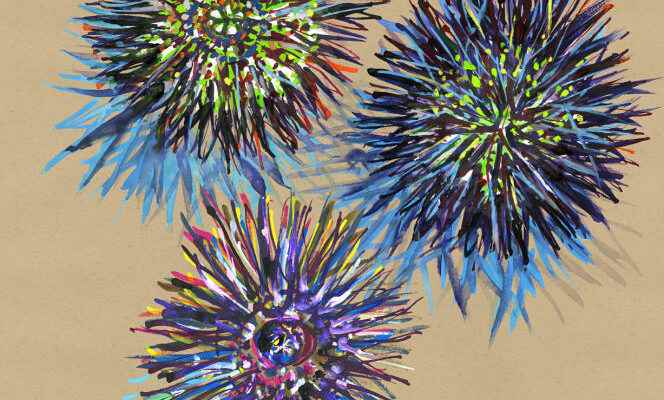It’s a pungent delicacy, adored by some, hated by others. Belonging to the family of echinoderms, the sea urchin, also called chestnut or sea urchin, is a strange marine animal, which already fascinated Aristotle, due to its internal structure and its incredible small toothed mouth located below the carapace (the test ), while the anus is at the top. Like its close relatives the starfish and the sea cucumber (holothurian), the sea urchin has a pentaradiate anatomy, i.e. it counts everything by five or its multiples: five teeth, twice five radial columns , five organ channels, a number of peaks, podions, pedicellaria and suckered feet always multiple of five… Black, violet, blue, crimson, white or even multicolored, with fine or large prickles (pencil sea urchin), hard and sharp or soft and flared (flower sea urchin), there are almost a thousand species of sea urchin, only a few of which are suitable for consumption.
On our coasts, it is essentially the purple sea urchin, or Paracentrotus lividus, which is consumed, particularly on the Mediterranean side. After decades of anarchic fishing, the sea urchin is now very protected, and its fishing is regulated, authorized from the beginning of November to mid-April, at the rate of four dozen sea urchins per day and per person, for a size limit of catch fixed at 5 centimeters in diameter, excluding quills. It was traditionally fished with the cramp (long and thin rake), using a bucket with a transparent bottom allowing them to be spotted on the rocks, but diving fishing has now taken over. Difficult to raise, due to its slow growth, the sea urchin remains a rare and expensive wild product, to be enjoyed in moderation.
Believed
Once opened (with large scissors, around the mouth) and emptied of its digestive system (the dark and viscous parts), the sea urchin is generally savored as it is, inside the shell itself. The creamy and orange-yellow parts that we eat, nicknamed tongues or coral, are actually the gonads, the animal’s genital glands.
Elaborated
With all due respect to purists, you can also cook sea urchin in all sorts of ways, by adding it to scrambled eggs, by integrating it into a royale (savory flan) or a delicate soufflé, on a nice salad or in grilled gyoza-style ravioli. Finally, we will never forget chef Pierre Gagnaire’s sea urchin bisque, made from roasted shells – an incredibly fragrant and iodized dish, both sweet and smoky, fine and powerful, with “Tastes of hazelnut, honey and blood”.
